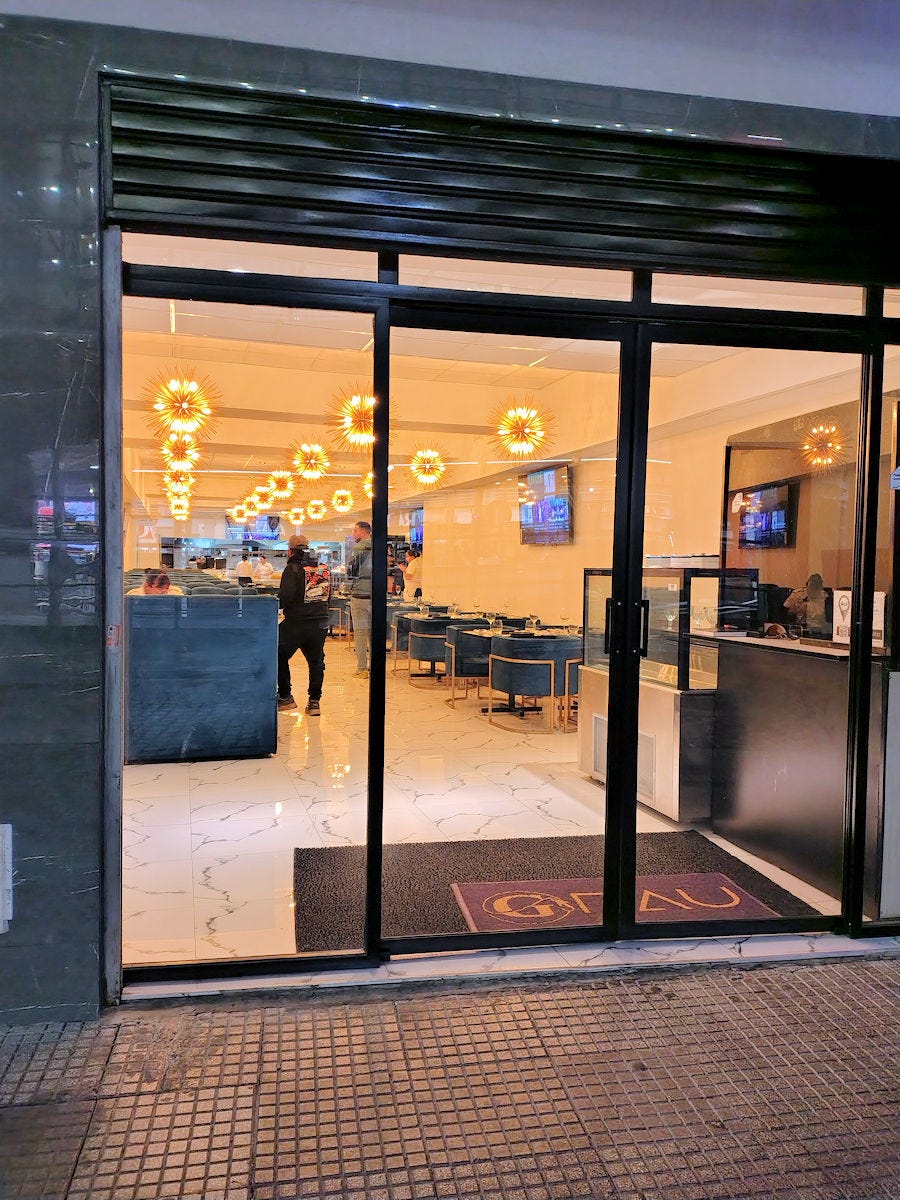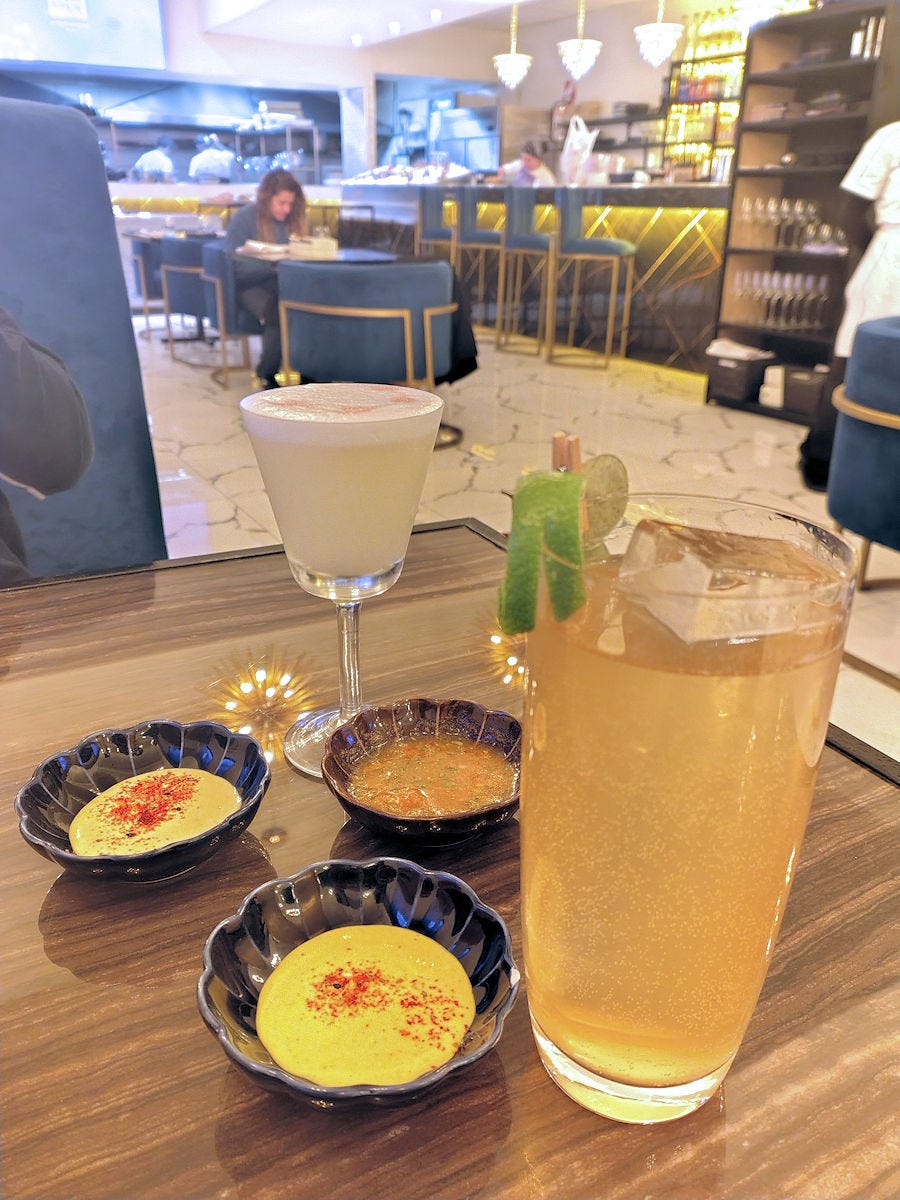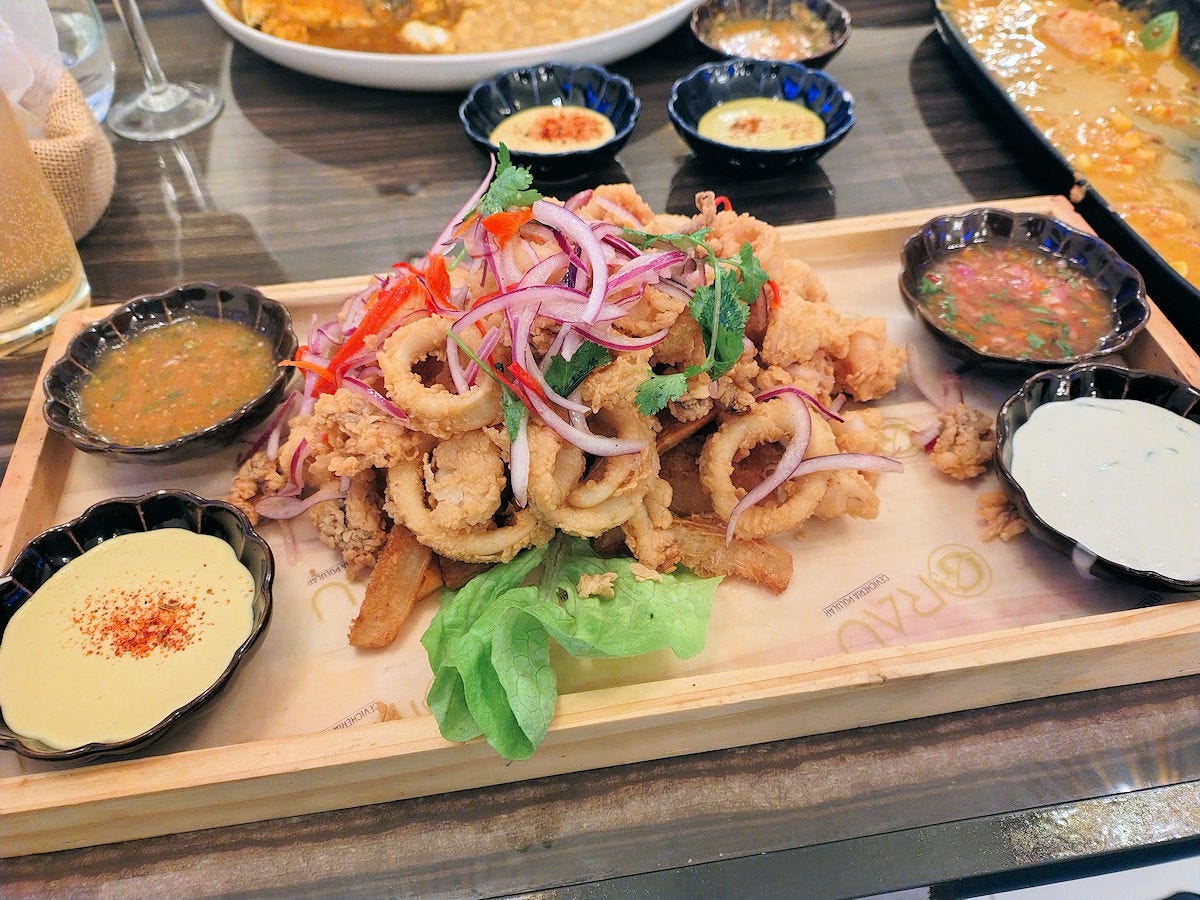Gentlefish of the Sea
In which we sample the offerings at a new Peruvian restaurant near the Abasto.
We have sampled the wares of chef Raul Zorilla at his three previous (and still extant) restaurants in town - Kamay Lounge, Kuro Neko, and Tori Chipchi. The first is an interesting, but not always successful Nikkei style restaurant, though I saw in Zorilla’s Instagram feed that he’s completely redoing it, and moving to a new location on Pasaje Carlos Gardel (formerly where Las Palmeras, and before that, Larco-Mar were located). The second is one of my favorite spots for sushi handrolls. And the third is a very good place focused on pollo a la brasa and pollo broaster - rotisserie chicken and fried chicken. So I was intrigued to see what he’d do with a seafood focused restaurant with adaptations of classic recipes.
Two visits in the last week or so to Grau Cebicheria, Guarda Vieja 3372, just a half block from the Abasto. First, the name - Grau is a tribute to Miguel Grau Seminario, a 19th century Peruvian naval officer who rose to prominence during the War of the Pacific where Peru and Bolivia allied against an incursion on their southern territories by Chile. Chile won and Peru and Bolivia lost a portion of their lands. Grau Seminario was known by the moniker of Gentleman of the Sea by both sides for his chivalrous treatment of captured enemy combatants. I get the ocean connection, though it seems a stretch extending it to the cooking of seafood. Then again, Zorilla’s naming of his previous restaurants has always been a bit offbeat.
The room is long and narrow. It’s really brightly lit, and mostly hard surfaces. With five large screen TVs all blaring out music videos on the first visit it was beyond noisy and distracting. On the second visit, they’d toned down the volume and the screens were just showing the album cover of whatever song was playing - far more conducive to dining. Twenty years of experience eating at Peruvian restaurants - I’ve never quite got the addiction to high volume noise in casual eateries, but it’s commonplace. It’s also common at home where my other half is often to be found with a movie or tv series playing at high volume, a music video at top levels blasting out of his laptop, and carrying on a multi-person video chat on his phone.
The menu is intriguing, and with the exception of two dishes offered for the non-seafood inclined, is all fish and shellfish. One option that is a specialty, which we didn’t take advantage of either night, is to pick your own whole fish from an array in front of the kitchen of whatever was freshest that day in the market, and have it prepared in one of two ways (42000 pesos, or about $32).
Cocktails were, of course, de rigeur, both my friend on the first visit and Henry on the second went with pisco sours, proclaimed good, if a touch sweet. I found the same with my chilcano, it was tasty, but just a touch sweeter than I tend to like. We noticed something similar with the huancaina sauce (front and center), one of two served with little nibbles of cancha (fried corn), chifles (fried plantain), and some sort of sweet, possibly plantain or sweet potato infused breadsticks. The sauce was sweet too - Henry offered that it was likely made using sweet crackers rather than bread or saltine style, a common approach particularly in and around Lima. The offered hot sauce is not particularly spicy (the back left there), but a rocoto based ajicito is available on request - though only one dish of it, if you ask for a second, there’s a charge of 1000 pesos. In fact, if you want more of any of the sauces, or for a to-go order, there’s a charge of either 1000 or 1500 pesos. And to-go leftovers if you don’t finish a dish and want to take it home get charged 500 pesos per plate. Seems a bit petty to me - I hate being nickled and dimed on stuff like that.
By the way, you can just barely see in the far back the ice-bed with all the fish on it where you go to select your whole fish if you want one.
On the first visit my friend and I elected to split a ceviche carretillero to start. I’d have to say it’s one of the better ceviches I’ve had in town, though it’s barely cured on arrival, so we tried it, but also let it sit a little while in the leche de tigre to become more ceviche-like and less sashimi-like. The accompanying rabas, or fried calamari were crunchy on the outside and tender on the inside, pretty much perfect. A very impressive start. 29000 pesos, $22, and a decent portion for two to share as an appetizer, or one person as their meal.
On the second visit, with Henry, we opted for one of the tiraditos. Lenguado, or sole, served uncured over a pool of a rocoto chili based leche. Not as successful as the ceviche - first, totally uncured, second, the fish is cut really unevenly, with some slices near see-through thin and others as thick as a pinkie finger. And, well, third, the finely chopped red onion in the mix was rather bitter - as if someone had skipped the step usually taken of soaking them for a short time in cold salted water to remove the bitterness. It’s rare that we don’t finish a ceviche type dish, but we didn’t on this one.
A recommended specialty of the house by our waitress on the first visit… oh… tangent moment…
So, service is a little odd. There were, both times, four waitresses on the floor. But only one takes orders, the other three deliver food, retrieve empty dishes, clean up, that sort of thing. On the first visit we ate early and it was fine, barely noticeable other than when waving someone down being told that we had to wait for the waitress who takes orders to come to the table, while the other three just stood around. On the second visit, it was really noticeable as the place was fairly busy, and she was more or less overwhelmed with taking orders, especially when one or another table monopolized her for an extended period - we were ready to order and ended up waiting about 7-8 minutes for her to finish off with one table that wanted all sorts of recommendations and descriptions of dishes, and the other waitresses just shrugged and said there was nothing they could do about it, they weren’t allowed to take orders. That’s just poor service, and if the place were really full, I’d likely just walk out.
Back to the dish. Something quite different, described as: "Tamal style Quinoa with Smoked Prawns - A memory from my childhood, a tamale made by Mrs. "Chinita" with my mom's quinoa stew, is the memory of my childhood that I put into this fusion of flavors today, finishing it with my personal touch: smoked prawns in anticuchera sauce, which gives rise to this creation for you.”
The quinua stew was fantastic. I’ve never had quinua cooked that way in a sort of mildly spicy, beautifully flavored porridge, and the prawns were lightly smoked and served with a scallop mayonnaise. Excellent dish. 28000 pesos, $21.50.
A rather whopping portion of chicharrón de calamares y chipirones - fried squid rings and baby squid. I ended up eating about half of it and taking the rest home… yes, I sprang for the 500 peso, 40¢, upcharge - it’s not the amount, it’s the principle. I did opt not to have a portion of each of the fours sauces - rocoto, chalaca, huancaina, and tartar - thrown into the to-go bag for an extra 4500 pesos, or $3.50. We’ve got hot sauces and such at home. Quite good by the way. I’ve had better, I’ve had worse, but I’d happily eat this again, and I like that there’s the selection of sauces for dipping.
I think, my favorite dish out of both dishes, though the quinua one vies for that. This is a fish version of the more common seco de cordero/carne norteño - one of Henry’s favorite dishes from his home region around Trujillo. Lenguado again, sole, bathed in the seco sauce - a blend, traditionally at least, of chicha de jora a sharp, corn based beer (or, if you can’t find it, a lighter beer plus a splash of vinegar), ají panka - dried red chilies, oregano, garlic, and onion. Served with white beans cooked with smoked bacon, rice, and yuca. Just fantastic, really. 30000 pesos, $23.
Now, we know I’m not a dessert person, but I’ve always been enamored of picarones, sweet potato doughnuts with cane syrup. So, couldn’t resist on that first visit. Unfortunately, I should have. Flavorless, still raw in the middle, and a syrup that had no heft to it - it was kind of watery and just tasted like sugar rather than the usual more molasses-y bite. My friend loves suspiro limeño, one of my least favorite Peruvian desserts. He loved it, I found it eye-wateringly sweet. 12000 pesos each, just over $9.
Your bill will arrive hidden inside a nautical vessel clock, along with a couple of wrapped candies. Cute, but a bit silly, especially because while the place has an overall seafood focus, there’s absolutely zero nautical or ocean or seafood themed décor anywhere else in the place. In fact, there’s no décor at all outside of some spiky hanging lights and TV screens. Just blank white walls.
Overall… mixed feelings. Three of the dishes just spectacularly good. Two… okay. And depending on whose tastes - two just no, or one no and one very good. Cocktails very good albeit tending sweeter than normal. Service, friendly, but in essence, becomes inattentive when they even start to get busy. And the whole “not my job” thing drives me nuts, in any restaurant or any service industry for that matter. I understand wanting some sort of control over the continuity of order taking, but not to the detriment of customer service - train at least one of those other three to be able to take orders when your main waitress is slammed. And again, while it’s not the amounts, the petty upcharges are a turn-off, especially for things that almost any restaurant in the city does for free.
So… Recommended, but with caveats. The place is new (opened at the end of May), so hopefully some of this stuff will get worked out.











